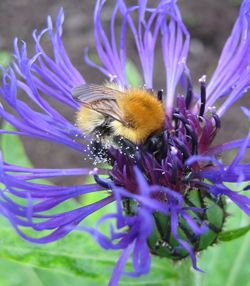Pesticides harm more than bees, says biologist’s study
Soil organisms, aquatic life and farmland birds may all be harmed by insecticides, according to a new study by University of Sussex biologist Professor Dave Goulson.
 Pollinators such as bumblebees might not be the only wildlife affected by neonicotinoids, says new research.
Pollinators such as bumblebees might not be the only wildlife affected by neonicotinoids, says new research.
Neonicotinoids – the most widely used insecticides in the world – have been in the news because of growing concern that they are linked to serious declines in bee species – resulting in April in a two-year EU ban of three neonicotinoids commonly used in Europe.
But Professor Goulson’s study – ‘An overview of the environmental risks posed by neonicotinoid insecticides’ – published today (Friday 14 June) in the Journal of Applied Ecology, draws together data from diverse sources including the agrochemical industry’s own research and reveals that harm to bees may be just the tip of the iceberg.
Neonicotinoids are mostly applied as seed dressings, intended to be absorbed by the crop, but well over 90 per cent of the active ingredient goes into the soil and leaches into groundwater, where it persists for years.
Data from agrochemical manufacturer Bayer on the persistence of neonicotinoids in soil are made widely available for the first time in Professor Goulson’s study. The data first came to light during investigations by the UK Parliament’s Environmental Audit Committee.
According to the data, neonicotinoids, if used regularly, accumulate in soil to concentrations far higher than those that kill bees, posing a risk to soil invertebrates and soil health.
Professor Goulson says: “Any pesticide that can persist for many years, build up in soil, and leach into waterways is likely to have effects far beyond the pest insects it intends to target. This is particularly so when the pesticide is highly toxic to non-target organisms. For example, less than one part per billion of the neonicotinoid imidacloprid in streams is enough to kill mayflies.”
The study also highlights risks for grain-eating birds such as partridge, which need eat only a few neonicotinoid-treated grains of crop to receive a lethal dose.
This latest evidence calls into question the effectiveness of the EU moratorium on the use of some neonicotinoids on flowering crops.
Professor Goulson says: “Neonicotinoids will still be widely used on cereals, so the broader environmental impacts are likely to continue. Given the longevity of these compounds, they would be in our soils for years to come even under an absolute ban, so two years is far too short to produce any benefit, even if there were any clear plan to monitor such benefits – which there is not. It is entirely unclear what this two-year moratorium is meant to achieve.”
Professor Goulson also draws attention to the lack of publicly available evidence on the effectiveness of neonicotinoids. He says: “Studies from the US suggest that neonicotinoid seed dressings may be either entirely ineffective or cost more than the benefit in crop yield gained from their use. We seem to be in a situation where farmers are advised primarily by agronomists involved in selling them pesticides.”
